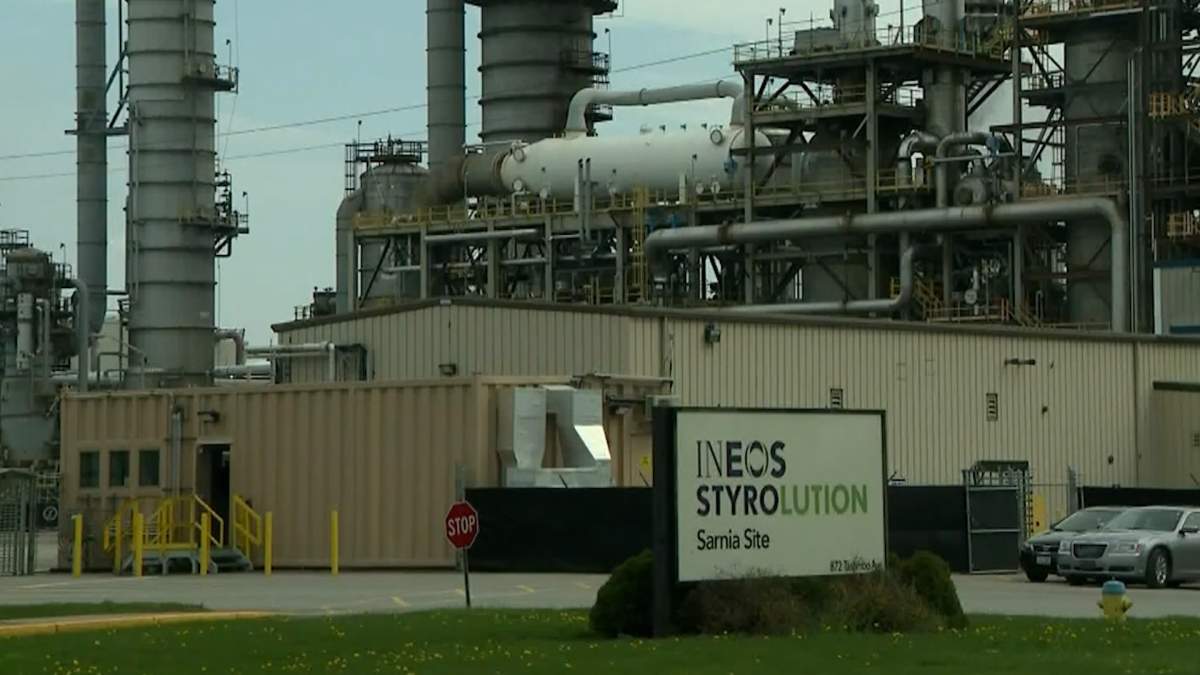The Ontario government says it’s taking swift action against a chemical plant following a spike in benzene readings and after members of Aamjiwnaang First Nation fell ill and were hospitalized.

While the Chief of the community says the government needs to shut down the Sarnia-area plant immediately and hinted at potential legal action, the Ministry of the Environment, Conservation and Parks issued a provincial order on Thursday against the plant in question INEOS Styrolution:
- It gives the chemical manufacturer one week to create a written plan to address the high levels of the cancer-causing chemical the government says its site is emitting.
- A copy of the report, obtained exclusively by Global News, shows INEOS also has roughly two weeks to implement new procedures to notify the public when levels of the carcinogen reach a certain hourly or daily threshold that can be toxic.
- The company has less than a month to complete an investigation into the apparent source of the chemical leak after dozens of residents in the small First Nation community of 900 in southwestern Ontario became sick.


The report said that “since 2023, the Company has unsuccessfully attempted to address the discharge of benzene into the air.

Get breaking National news
“The Ministry remains concerned that adequate actions have not been undertaken to date.”
Ontario Environment Minister Andrea Khanjin said at a press conference Friday the province “made it really clear as to what next steps need to be done.”
“We’ll continue to ensure that INEOS is responsible for their pollution, their emission, and we will do whatever it takes to hold them to account,” Minister Khanjin said in response to questions from Global News.
The company did not respond to a detailed list of questions Friday.

In a previous statement, David R. MacDonald, the operations manager and interim site director for INEOS Styrolution, said the company is “carefully reviewing” concerns raised by Aamjiwnaang First Nation regarding benzene readings from the INEOS site.
“The site works closely with the (Ministry of the Environment, Conservation and Parks) to ensure we stay within the prescribed emissions limits,” MacDonald wrote in an email.
The Aamjiwnaang First Nation has criticized the government, saying the provincial orders don’t go far enough and called for a complete shutdown of the plant.
Over the last five years, four provincial orders have now been issued against INEOS to address its benzene emissions, but the ministry has never issued a fine to the company’s Sarnia site as a result.
“We are going to have to look deeper for support, including court action,” Aamjiwaang Chief Chris Plain said in a statement on social media Thursday.
A Global News investigation in 2017 revealed the serious health effects that residents of the First Nation and the city of Sarnia were suffering and possible links to the proximity of refineries and chemical plants in the area known as “Chemical Valley.”

Following the investigation, the Ontario government launched a multi-million-dollar project to examine the possible connection between air pollution from industrial plants and public health.
Cathleen O’Brien, with the Aamjiwnaang First Nation Environment Department, wrote a four-page response to the ministry indicating the First Nation was never consulted before the province issued the orders Thursday and again called for a shutdown of the plant.
“Compel the INEOS facility to begin a safe shutdown of the facility and, if there are plans to restart the facility, require that the facility first obtain an approval from the AFN,” O’Brien wrote, noting a number of fixes the company needs to make in how it stores and detects benzene emissions.
Scott Grant, a retired engineer formerly with Ontario’s Environment Ministry, said if INEOS fails to follow through on the compliance orders, the province would face a protracted legal battle.
“Prosecutions like this do happen with a subsequent fine, but instead there can be a re-negotiation of the order conditions,” Grant said. “In Ontario, provincial officer’s orders are a bit of a gift to a company and can be used as a means to delay significant pollution abatement action.”
The ministry report detailed significantly high benzene emissions it says have been coming from the plant since Jan. 1, 2024.
Ontario’s Environment Ministry has set the annual average limit for benzene at 0.45 ug/m3 (micrograms per cubic metre). The province does not regulate the hourly limit.
Global News has previously reported that average levels of the chemical at the First Nations’ northern border surpassed 100 ug/m3 for 14 hours between April 1 and April 16, reaching as high as 150.5 ug/m3 on April 14.
The ministry now says in its report the “elevated benzene concentrations” first began in January 2024.
“Between March 29 and April 16, 2024, there were 18 instances where 1-hour benzene concentrations exceeded 90 µg/m3,” the provincial report said.
New fines for the companies caught polluting the air could also be on the way, according to a draft copy of an update to the Petroleum Refining and Petro-Chemical Industry Standards, which governs chemical and oil refining industry.
Companies could now face fines of up to $100,000 for releasing benzene over a health benchmark of 90 ug/m3 (micrograms per cubic metre) per hour or 30 µg/m3 over 24 hours. On April 16, the day many residents reportedly felt ill, the benzene levels hit 115 ug/m3 early that morning.





Comments